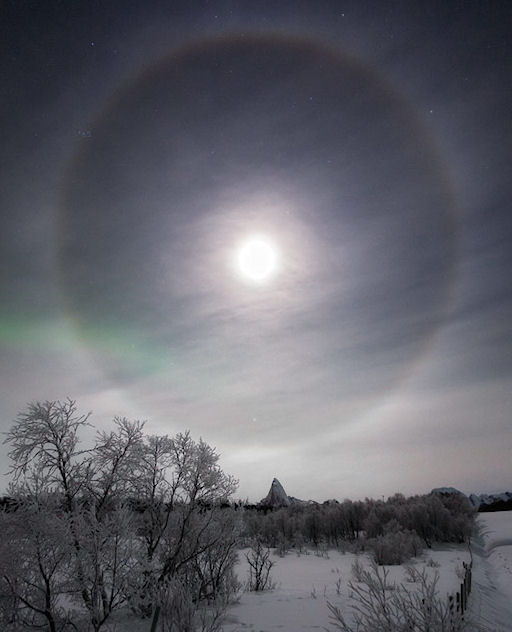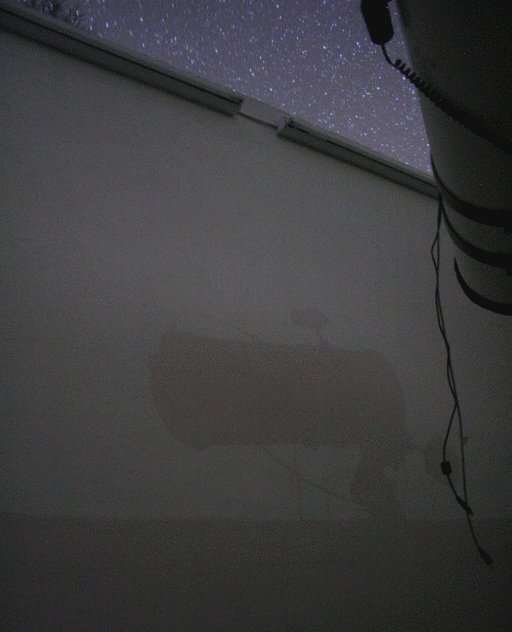Metallic photos of the sun by renowned photographer Greg Piepol bring together the best of art and science. Buy one or a whole set. They make a stellar gift. | | |
QUIET SUN: Big sunspot 1147 is crackling with B-class solar flares. These eruptions are feeble, however, compared to several flamboyant explosions the same region produced last week while it was on the far side of the sun. Barring a return to form by sunspot 1147, solar activity is expected to remain low for at least the next 24 hours.
BE ALERT FOR MOON HALOS: The Moon is waxing full and ice is in the air. That means it's time to be alert for Moon halos. Håkon Iversen saw this one on Jan. 13th just outside Sortland, Norway:

"I was out looking for auroras (and, indeed, there were some green lights in the sky), but the Moon stole the show," says Iverson. "This halo is one of the most awesome things I've ever seen."
Moon halos are formed by ice crystals, which catch moonbeams and bend them as shown. The brighter the Moon, the brighter the Moon halo, so any halos this week should be very bright indeed. The Moon is full on Jan. 19th. Browse the links below for more examples of what's in store.
moon halos: from Rosenberg Róbert of Adony, Hungary; from Anett Mikalsen of Andøy, Norway
SHADOWS OF VENUS: Wake up before dawn, look east, and you'll see: Venus is bright. How bright is it? The silvery second planet from the sun is so bright, it actually casts shadows. In the south of France on the morning of Jan. 12th, Vincent Jacques photographed the Venus-shadow of his own telescope:

"I was observing from a place with absolutely no artificial lights," notes Jacques. "Also, the Moon was absent from the morning sky. It was uttterly dark except for Venus, which was blazing bright at magnitude -4.4. I recorded the shadow using a Canon EOS 350D digital camera in a series of 135s exposures at 1600 ISO."
Venus-skeptics should watch the 5-frame animation. The shadow sets as Venus rises, a see-saw motion that eliminates any doubt. The Morning Star is bright, indeed.
January 2011 Aurora Photo Gallery
[previous Januaries: 2010, 2009, 2008, 2007, 2005, 2004]
Solar Eclipse Photo Gallery
[NASA: Hinode Observes Annular Solar Eclipse]
Potentially Hazardous Asteroids (
PHAs) are space rocks larger than approximately 100m that can come closer to Earth than 0.05 AU. None of the known PHAs is on a collision course with our planet, although astronomers are finding
new ones all the time.
On January 18, 2011 there were 1183 potentially hazardous asteroids.
Recent & Upcoming Earth-asteroid encounters: | Asteroid | Date(UT) | Miss Distance | Mag. | Size |
| 2011 AH5 | Jan 13 | 3.3 LD | 26 | 28 m |
| 2011 AY22 | Jan 14 | 4.1 LD | 27.1 | 17 m |
Notes: LD means "Lunar Distance." 1 LD = 384,401 km, the distance between Earth and the Moon. 1 LD also equals 0.00256 AU. MAG is the visual magnitude of the asteroid on the date of closest approach. | | The official U.S. government space weather bureau |
| | The first place to look for information about sundogs, pillars, rainbows and related phenomena. |
| | Researchers call it a "Hubble for the sun." SDO is the most advanced solar observatory ever. |
| | 3D views of the sun from NASA's Solar and Terrestrial Relations Observatory |
| | Realtime and archival images of the Sun from SOHO. |
| | from the NOAA Space Environment Center |
| | the underlying science of space weather |

